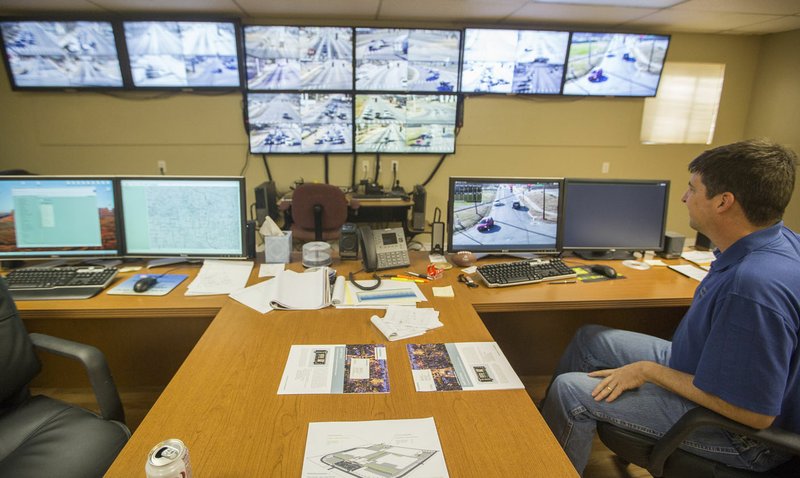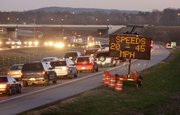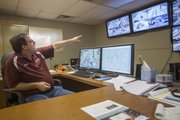Building new roads and expanding existing ones will likely remain the primary answer to the region’s traffic woes, but less costly and quicker solutions can be as easy as improved timing between signals or restricting where and how cars enter a road, experts said.
Other tactics, like faster travel lanes and roads that change direction with traffic flow won’t necessarily help around here, said David Schrank, researcher with the Texas A&M Transportation Institute.
People in Northwest Arkansas live and work in all corners of the two-county area, with almost equal amounts of traffic headed both directions in the mornings and evenings.
Many urban areas have core business centers that see a high influx of incoming traffic in the morning and outgoing in the evening, such as working downtown and living in the suburbs, Schrank said.
Still, the area should do what it can in addition to road work, he said.
“Do everything possible to make the whole system work more efficiently,” Schrank said. “While it may take five to 10 years to build new roads, you can often make more minor changes in five to 10 months.”
Lights can be synchronized so a vehicle, traveling the speed limit, can move through an area with minimal stops. Other signal programs detect when traffic has built up to a certain point and change to allow the cars through.
Areas with heavy traffic flow in one direction can set up traffic signals to allow more cars to pass in one direction at certain times of the day or have traffic lanes that can be used for different directions at various times. These are called adaptive lights.
Access management
a less expensive way to control traffic. The National Cooperative Highway Research Program defines access management as the “systematic control of the location, spacing, design and operation of driveways, median openings, interchanges and street connections to a roadway.”
Chris Brown, Fayetteville city engineer, said access management designs are a less costly alternative when implemented on the front end of a project, but can be difficult to retrofit. He said the Fayetteville master street plan includes items such as boulevards and roundabouts.
“You get much higher safety and capacity when you limit access to a road,” he said.
Mike Churchwell, Bentonville transportation director, said traffic comes down to volume versus capacity.
“We have more volume of traffic than we have the capacity to move it efficiently,” he said.
He said it’s difficult playing catch-up, and he is constantly fielding traffic complaints.
“I have to remind people that I also have to drive through the same traffic, and we are doing the best we can,” he said. “You are behind the eight ball before you can even get projects going. Things in the transportation world don’t happen quickly.”
Projects face delays as leaders seek the money to do the work. It also takes time to design the road, do required studies, acquire the land and move utilities.
Nathan Becknell, Rogers project engineer, echoed that sentiment.
“In transportation terms, we deal in years and decades,” he said.
MAKING A PLAN
The A&M Transportation Institute did a congestion study for the Northwest Arkansas Council in 2012 that identified the area’s most congested areas based on vehicle speed during peak morning and evening hours and traffic counts.
The region’s top trouble areas occur on and around Interstate 49, led by a section of U.S. 71 south from Riordan Road to Peach Orchard Road in the mornings. Several entrance ramps and interchanges also made the list.
Tim Conklin, the Northwest Arkansas Regional Planning Commission’s transportation programs manager, said traffic hasn’t changed much since the institute’s study. Portions of the 2012 report helped the commission craft a Congestion Management Process Report earlier this year.
The plan is required by the Federal Transit and Federal Highway administrations in areas with populations of more than 200,000. Northwest Arkansas’ population surpassed 500,000 last year.
The council’s plan makes several of the same recommendations found in the Urban Mobility Report, including traffic signal timing, access management, intersection control and added capacity. All are in the works in various places and stages across the region. Widening roads is the most expensive recommendation.
The recommendations involve bringing “big city things to places that aren’t big cities such as full-time cameras that monitor.” That means a city can respond the second something happen.
SIGNALING HELP
All of Northwest Arkansas’ largest cities use cameras to help traffic signals know how to respond and to give workers an opportunity to diagnose and sometimes fix problems remotely.
Becknell said Rogers has 93 signals and beacons, including two flashing lights and two pedestrian-only beacons. One-third are adaptive, meaning they automatically adjust to changing traffic patterns to help alleviate congestion.
The Federal Highway Administration includes information about adaptive signals in its Every Day Counts Exchange to promote time and money saving initiatives. The agency reports adaptive signals can reduce traffic delays by up to 50 percent, lowers fuel consumption and greenhouse emissions and increase safety.
Adaptive signals have traffic sensors that collect data, and a program evaluates the information to determine when and how long lights should be green.
Becknell said the adaptive signals installed along New Hope Road in 2009 were the first in the state.
Dub Janczys, Springdale’s signalization supervisor, said the city has 80 traffic signals; three main roads have adaptive lights and the majority of the rest are coordinated.
Signals in coordinated systems progress in sequence so platoons of vehicles can proceed through a continuous series of green lights. These systems are typically maintained by an outside company that comes in when requested to adjust the timing.
Janczys pointed to construction on Arkansas 265 last year, which closed a section of the road for a while and shifted traffic to other roads. The signals on the detour roads were adjusted to ease the additional traffic on those roads.
“What we are seeing now is people trying to get off I-49 because of the construction,” he said. “We have not made many changes, but are in the monitoring stages right now. The challenge is to keep things moving.”
Fayetteville has about 105 traffic signals, and College Avenue is coordinated, said Terry Gulley, transportation services director.
“If you can hit it just right and run the speed limit, you can make it from one end to the other without hitting a red light,” he said.
Bentonville has 41 signalized intersections, and 38 are monitored in a traffic control center.
CONTROLLING CHANGES
Bentonville’s center features eight 46-inch televisions, which monitor 38 of the city’s signalized intersections. The screens typically display four views at a time, showing all four directions at a given intersection.
Traffic technicians Brad Conley and Rob Kintz usually keep an eye on the screens during the busiest traffic times of 7-9 a.m. and 11 a.m.-1 p.m. Conley said the afternoon’s traffic is harder to predict with steady flows starting around 2:30 p.m.
Kintz said Arkansas 102 and all areas around the interstate are busy all day, and the biggest complaint they deal with is a signal not cycling. They can diagnosis a problem and either fix it from the office or head to the site. They can also monitor issues remotely on an iPad.
“It is a pretty advanced system for a city of our size,” Churchwell said.
Janczys said all of Springdale’s intersections with traffic lights have cameras, but the video is just used to look at vehicles approaching an intersection. The cameras can be accessed from any computer connected to the city’s network, and Janczys said the days of running out to a signal every time there is an issue are over.
Becknell said a regional traffic management center would help across the entire area but for now is handled by individual cities. Traffic management centers serve as mission control for an urban area’s major street and highway network. Employees monitor traffic signals, intersections and roads around the clock to keep traffic flowing.
Danny Straessle, spokesman for the Arkansas Highway and Transportation Department, said the state is exploring establishing a statewide system, but it is part of a longrange plan that could take 10 years to implement.
AUTOMATED INFORMATION
Arkansas operates automated work zone information systems at some construction projects. Straessle said traffic radar sensors measure and post vehicle speed and display information warning of speed changes ahead or lane closures in and around work zones.
Signs along I-49 receive speed data and alert drivers of slowing traffic ahead. The signs display messages such as “Drive Safely” and “Buckle Up” when traffic is moving at normal speeds. The signs switch to messages like “Speeds 20-45 mph.” The idea is to reduce rear-end accidents.
“That is something we are getting ready to take statewide,” Straessle said.
Permanent message boards along I-49 will be put in place once construction is completed to display messages when weather or accidents impact travel, he said. The boards will not be able to provide real-time information unless a traffic control center is established and someone is on hand to respond to the minute-to-minute changes.
OTHER OPTIONS
One option not used in Northwest Arkansas that could help with high-volume interchanges is ramp metering. A signal at a ramp keeps cars from entering the interstate for a set amount of time to keep the rest of the traffic moving at a constant speed, Schrank said. This would not necessarily be needed throughout the corridor, but in problem areas.
Becknell said new ideas often meet with opposition, but people adapt.
One feature being utilized more often locally are roundabouts. Rogers installed one on Pauline Whitaker Boulevard, and he said “while people are getting used to it, they still get confused by the road configuration.
“In a dual-lane roundabout, the outside lane is an exit only. It’s hard to get the word out,” he said.
Brown said a planned extension of Rupple Road from Martin Luther Kind Boulevard to Persimmon Street will include three roundabouts. He said roundabouts handle the traffic peaks and valleys better than stop lights because it keeps vehicles moving all the time.
Well-designed roundabouts with the correct striping makes it difficult for drivers to make mistakes, he said.
Access management is another way to control traffic but also faces opposition. Conklin said planners are examining partial access control on a portion of Arkansas 265 between Randall Wobbe and Arkansas 264 in Springdale. Limiting the number of entry points onto a road with medians and access roads funnels traffic to controlled intersections, he said.
Patsy Christie, Springdale planning director, said that stretch of Arkansas 265 won’t have any medians, but officials are exploring limiting the number of driveways. She said a road alignment has been mapped out, and the project is “a little further along than preliminary.
“Too many intersections kill the traffic flow,” she said.



